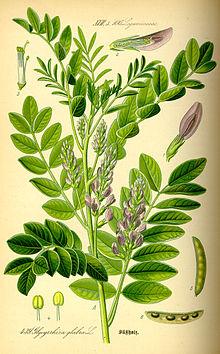Licorice, Liquorice شیرین بیان
DESCRIPTION
Licorice is the root of Glycyrrhiza glabra from which a somewhat sweet flavour can be extracted.There are two main methods of making licorice extract . In both methods, the roots of the licorice plants are harvested and dried, after which they are cleaned. In the first method, the licorice roots then are ground into powder, which can then be used as is or mixed with water. In the second (more modern) method, the roots are pulped and boiled, and the extract is concentrated by allowing the water to evaporate. If the extract is in dried form, it can be stored indefinitely. Liquorice or licorice is the root of Glycyrrhiza glabra from which a somewhat sweet flavor can be extracted. The liquorice plant is a legume that is native to southern Europe and parts of Asia.
Much of the sweetness in liquorice comes from glycyrrhizin, which has a sweet taste, 30–50 times the sweetness of sugar. The sweetness is very different from sugar, being less instant, tart, and lasting longer.
Liquorice, which grows best in well-drained soils in deep valleys with full sun, is harvested in the autumn two to three years after planting. Countries producing liquorice include Iran, Afghanistan, the People’s Republic of China, Pakistan, Iraq, Azerbaijan, Uzbekistan, Turkmenistan, and Turkey.

HISTORY
Licorice has a long and honorable history in the service of mankind. The earliest usage of Licorice was back in the first syllables of recorded time. Licorice freaks throughout history have included Pharaohs and Prophets. Generous supplies were discovered in Emperor King Tut’s tomb, while Egyptian hieroglyphics record the use of Licorice in a popular beverage by men in the days when the Bible was still being written! Alexander the Great, the Scythian armies, Roman Emperor Caesar, and even India’s great prophet, Brahma, are on record endorsing the beneficial properties contained in Licorice. Warriors used it for its ability to quench thirst while on the march, while others (including Brahma and venerable Chinese Buddhist sages), recognized Licorice’s valuable healing properties . Licorice Root is one of those herbs that has been around since ancient times. It was found in great quantities in the tomb of King Tut among his gold, jewelry and art treasures. It was presumed that King Tut wanted to take the root with him on his journey to the next world so that he could make his sweet drink “Mai sus” when he got there. To the Egyptians the sweet tasting Licorice root was a cure-all, much in the same manner that Chinese relate to Ginseng. Remarkably the licorice root was extremely well preserved when it was found by archaeologists, this may be due in part by the unusual preservation qualities the shape of the pyramid has.
Licorice root was used in other areas of the ancient world, the Brahmans of India, the Hindus, Greeks, Romans, Babylonians and Chinese. The ancient Hindus believed it would increase sexual vigor when prepared as a beverage with milk and sugar. The Scythians taught the use of the herb to the Greeks; Theophrastus called it Scythian root, writing in the third century B.C. The Scythians were able to go twelve days without drinking water because they chewed on Licorice root and ate mare’s cheese. He also said it was good for coughs and all pectoral diseases. In about 80 AD, Pliny recommended Licorice root to clear the voice and to alleviate thirst and hunger.
Dioscorides, an herbal physician, gave the plant its botanical name (Greek glukos = sweet, riza = root). Dioscorides traveled with the army of Alexander the Great, he told the troops to carry and chew Licorice root in order to allay their thirst when water was scarce and to give them stamina and endurance during their long marches. He also said that it was good for stomach trouble, throat trouble and liver and kidney disorders. It is not known if they had the same trouble that was reported by Napoleon in France; he habitually chewed Licorice root, which eventually blackened his teeth.
During the Middle Ages, Licorice was often taken to alleviate the bad effects of highly spiced and overcooked food, fat and often-contaminated meats, as refrigeration was impossible and most meats were preserved by salting and by packing with aromatic herbs and spices. During this time Licorice extract was said to be equal to that of “grains of paradise”, it is not know what that is but it sounds of importance to be documented. To back up the value of licorice, it was reported that a tax was placed on licorice imports to aid in repairing the London Bridge during the reign of Edward I in 1305. About the middle of the fifteenth century, Licorice was named among the wares kept by the Italian apothecaries and it is enumerated in the list of drugs of the City of Frankfurt, written about the year 1450. It was not only important medicinally, but was used as a flavoring agent in sweets and tobacco, and as a foaming agent in fire extinguishers and beers, and used in isolated millboard.
Licorice is imported chiefly from Spain and Italy, the warmer more temperate countries, but cultivation has existed on a small scale in England. Dominican friars introduced licorice to England by bringing it to Yorkshire Dales around the 15th century, where it became famous as an ingredient in Pontefract cakes. In Turner’s herbal we learn that the planting and growing of licorice in England began about the first year of Queen Elizabeth, which was in 1558. Culpepper stated, “It is planted in fields and gardens, in divers places of this land and therefore good profit is made.” In the 1800’s Culpepper included information about Licorice in his famous herbal writings. Southern Europeans drank large amounts of Licorice water (tea) because they believed it to be a blood purifier.
It was the English who introduced the herb to the American Indians, which is strange because it was usually the other way around. John Josselyn of Boston in the sixteenth century lists Licorice as one of the “precious herbs” he brought over from England. He would brew a beer for the Indians when they had a bad cold. It was strongly flavored with elecampane, Licorice, aniseed, sassafras and fennel.
Licorice is official in all pharmacopoeias, which only differ as to which variety is recognized, the botanical name, and whether the accepted root be peeled or unpeeled.
If we look at the use of licorice from a western perspective, we see that its use has changed little over 3,000 years. It is considered demulcent (soothing to irritated membranes), expectorant (loosening and helping to expel congestion in the upper respiratory tract), and stimulates mucous secretions of the trachea. Other well-documented activities include significant anti-inflammatory effects, a protectant effect on the liver against toxic substances and anti-allergic activity.
USES
In addition to its medicinal uses, licorice has been used as a flavoring agent, valued for sweetness (glycyrrhizin, a component of licorice, is 50 times sweeter than table sugar). The generic name “glycyrrhiza” stems from ancient Greek, meaning “sweet root.” It was originally used as flavoring for licorice candies, although most licorice candy is now flavored with anise oil. Licorice is still used in sub-therapeutic doses as a sweetening agent in herbal medicines, lozenges, and tobacco products (doses low enough that significant adverse effects are unlikely).
Much liquorice production goes toward flavouring, sweetening and conditioning tobacco products. Liquorice adds a mellow, sweet woody flavour and enhances the taste of tobacco. The burning liquorice also generates some toxins found in the smoke, and the glycyrrhizin expands the airways, which allows users to inhale more smoke.
The uses of licorice extract are many. It is most commonly used in candy making, but is also used in the treatments of conditions such as sore throats, irritable bowel syndrome (IBS), and skin diseases such as psoriasis. It also is used in nonfood and nonmedicinal ways. For example, it is one of the foaming agents in fire extinguishers.
Tobacco: Most liquorice is used as a flavoring agent for tobacco.Liquorice provides tobacco products with a natural sweetness and a distinctive flavor that blends readily with the natural and imitation flavoring components employed in the tobacco industry. It represses harshness and is not detectable as liquorice by the consumer. Tobacco flavorings such as liquorice also make it easier to inhale the smoke by creating bronchodilators, which open up the lungs. Chewing tobacco requires substantially higher levels of liquorice extract as emphasis on the sweet flavor appears highly desirable.
Food and candy:Liquorice flavour is found in a wide variety of liquorice candies or sweets. In most of these candies the taste is reinforced by aniseed oil so that the actual content of liquorice is very low. Liquorice confections are primarily purchased by consumers in the European Union. In the Netherlands, where liquorice candy (“drop”) is one of the most popular forms of sweets, only a few of the many forms that are sold contain aniseed, although mixing it with mint, menthol, or with laurel is quite popular. Mixing it with ammonium chloride (‘salmiak’) is also popular. The most popular liquorice, known in the Netherlands as zoute drop (salty liquorice), actually contains very little salt, i.e., sodium. The salty taste is probably due to ammonium chloride and the blood pressure raising effect is due to glycyrrhizin. Strong, salty candies are popular in Scandinavia.
Liquorice is popular in Italy (particularly in the South) and Spain in its natural form. The root of the plant is simply dug up, washed, and chewed as a mouth freshener. Throughout Italy unsweetened liquorice is consumed in the form of small black pieces made only from 100% pure liquorice extract; the taste is bitter and intense. In Calabria a popular liqueur is made from pure liquorice extract. Liquorice is also very popular in Syria where it is sold as a drink. Dried liquorice root can be chewed as a sweet.
Medicine: The compound glycyrrhizin (or glycyrrhizic acid), found in liquorice, has been proposed as being useful for liver protection in tuberculosis therapy, however evidence does not support this use which may in fact be harmful. Glycyrrhizin has also demonstrated antiviral, antimicrobial, anti-inflammatory, hepatoprotective, and blood-pressure increasing effects in vitro and in vivo, as is supported by the finding that intravenous glycyrrhizin (as if it is given orally very little of the original drug makes it into circulation) slows the progression of viral and autoimmune hepatitis. Liquorice has also demonstrated promising activity in one clinical trial, when applied topically, against atopic dermatitis. Additionally liquorice has also proven itself effective in treating hyperlipidaemia (a high amount of fats in the blood). Liquorice has also demonstrated efficacy in treating inflammation-induced skin hyperpigmentation. Liquorice may also be useful in preventing neurodegenerative disorders and cavities. Anti-ulcer, laxative, anti-diabetic, anti-inflammatory, immunomodulatory, antitumour and expectorant properties of liquorice have also been noted. Liquorice may be useful in conventional and naturopathic medicine for both mouth ulcers and peptic ulcers.
MEDICINAL USES
Licorice is used for various digestive system complaints including stomach ulcers, heartburn, colic, and ongoing inflammation of the lining of the stomach (chronic gastritis).
Some people use licorice for sore throat, bronchitis, cough, and infections caused by bacteria or viruses.
Licorice is also used for osteoarthritis, systemic lupus erythematosus (SLE), liver disorders, malaria, tuberculosis, food poisoning, and chronic fatigue syndrome (CFS).
Licorice is sometimes used along with the herbs Panax ginseng and Bupleurum falcatum to improve the function of the adrenal glands, especially in people who have taken steroid drugs long-term. Steroids tend to suppress the activity of the adrenal glands. The adrenal glands produce important hormones that regulate the body’s response to stress.
Licorice is also used in an herbal form called Shakuyaku-kanzo-to to increase fertility in women with a hormonal disorder called polycystic ovary syndrome. In combination with other herbs, licorice is also used to treat prostatecancer and the skin disorder known as eczema. Some people use licorice as a shampoo to reduce oiliness in their hair.
